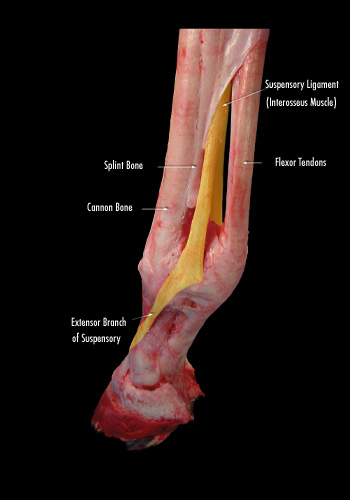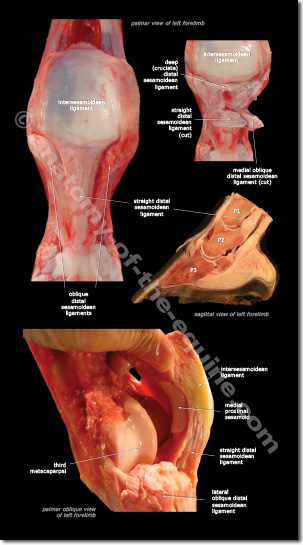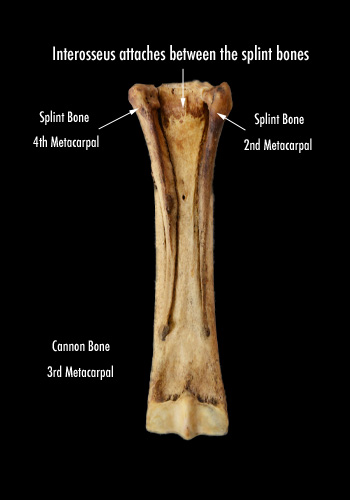The Suspensory Ligament
The suspensory ligament plays a very important role in preventing excessive extension of the fetlock during movement.
If you compare the two photos below, it becomes clear exactly how much strain the suspensory can be subjected to during extreme sports. It is not surprising therefore, that this structure is frequently injured.
|
The suspensory ligament has been highlighted with a yellow overlay. |
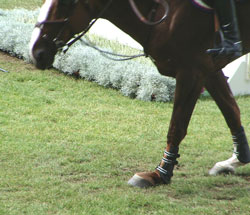 Photo of jumping horse courtesy of Dr. Gaspar Castelijns. The force energy the ligament is subjected to during strain is converted into forward/upward motion and is what gives the horse 'spring'. Think of a stretched rubber band that pings back into shape when it is released. This is an amazing engineering feat. |
Suspensory apparatusThe suspensory ligament does not work alone. There are many other structures that work in conjunction with this primary ligament. Collectively, they are referred to as the 'suspensory apparatus'. Here is a page from our latest project - Tendons & Ligaments Guide. It shows many of the other supporting ligaments that make up the suspensory apparatus. |
Interosseus Muscle (suspensory ligament)
Muscle or Ligament?
Despite the common belief that there are no muscles in the distal limb of the horse, there actually is some. Many of the tendons and ligaments of the lower leg derive from muscle tissue and it is common to see them referenced as muscles in various anatomy books.
The Suspensory Ligament (SL) is not only comprised of ligamentous fibers, there are also some muscle fibers present.
Here is a brief summary of a wonderfully written article produced at UC Davis:
The suspensory is an evolutionary derivative of a muscle called the interosseous medius. Animals that have more than one digit share this muscle (primates, felines, canines).
The SL is made up of predominately ligament fibers with some residual muscle fibers. The muscle fibers are more prevalent in the upper portion of the suspensory ligament.
The variation in the amount of muscle fibers can create issues when diagnosing suspensory problems. It can be hard to differeniate between normal muscle fibers and damaged ligamentous tissue.
Since the SL derives from the interosseus medius it is easier to understand why many of the anatomy books refer to the SL as a muscle.
In medical terminology, interosseous literally means: a muscle lying between bones.
The suspensory ligament attaches in the channel created by the two splint bones. It is a muscle lying between bones.
Subscribe to Anatomy of the Equine News
Stay informed by subscribing to our newsletter and receive a FREE copy of our Distal Limb, Laminae & Digital Cushion eBook as a thank you!
Look for New! bundles
Bundles
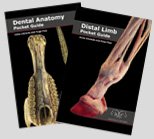 Head to Hoof Printed Pack Buy the Dental Anatomy Guide along with the Distal Limb Guide and save $10 on the combined price and we'll give you a free copy of the Digital Pulse eBook too! Pack price: $40 |
|
Head to Hoof eBook Pack Same books as above but all in eBook format. Price: $25 |
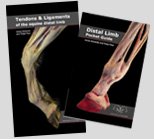 Leg Printed Pack Buy the Tendon & Ligament Guide along with the Distal Limb Guide and save $10 on the combined price and we'll give you a free copy of the Coffin Bone eBook too! Pack price: $50 |
|
Leg eBook Pack Same books as above but all in eBook format. Price: $35 |
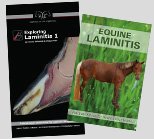 Laminitis Pack Buy Exploring Laminitis along with the Equine Laminitis Guide and save $10 on the combined price and we'll give you a free copy of the Digital Pulse eBook too! Pack price: $40 |
|
Laminitis eBook Pack Same books as above but all in eBook format. Price: $28 |
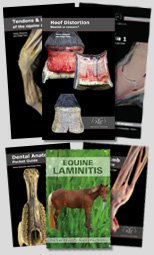
NEW!
Everything Pack
Buy all six books including the new Hoof Distortions book: Hoof Distortions; Tendon & Ligament Guide; Distal Limb Guide; Exploring Laminitis; Equine Laminitis Guide; and Dental Anatomy Guide and save $30 on the combined price and we'll give you a free copy of the Coffin Bone eBook ($10 value) and Digital Pulse eBook ($3 value) too!
Pack price: $150
NEW!
Everything eBook Pack
Same books as above but all in eBook format.
Price: $100
Poster
Bundles
|
Back in Stock! 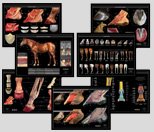 Buy a set of SEVEN posters and save $10 per poster. Pack price: $70 |
